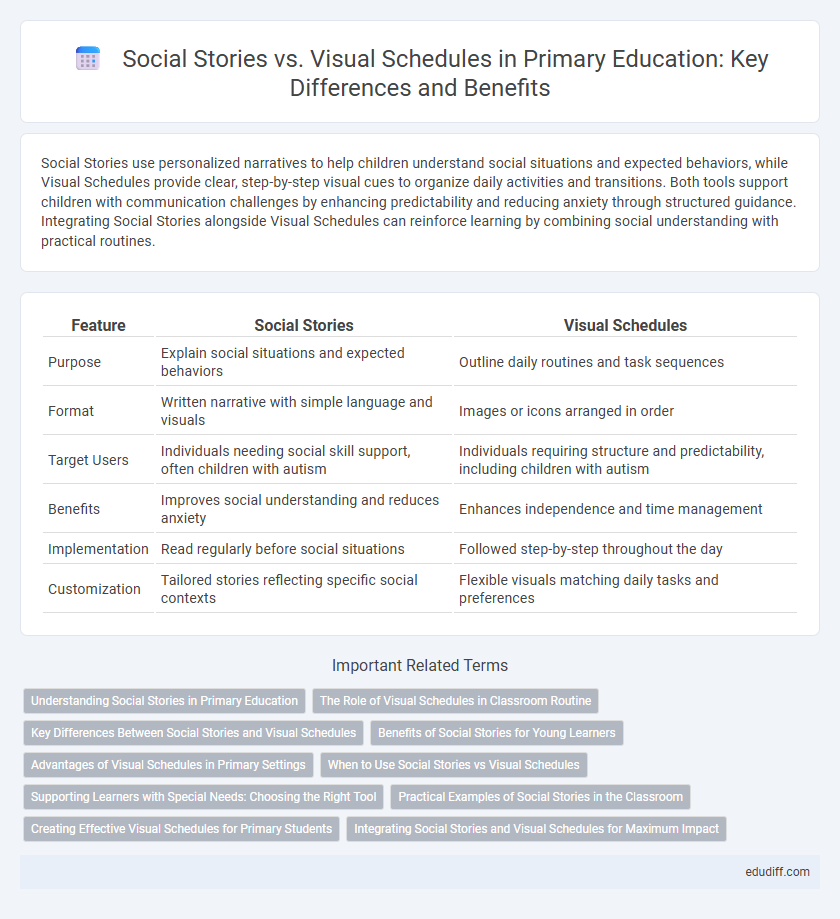Social Stories use personalized narratives to help children understand social situations and expected behaviors, while Visual Schedules provide clear, step-by-step visual cues to organize daily activities and transitions. Both tools support children with communication challenges by enhancing predictability and reducing anxiety through structured guidance. Integrating Social Stories alongside Visual Schedules can reinforce learning by combining social understanding with practical routines.
Table of Comparison
| Feature | Social Stories | Visual Schedules |
|---|---|---|
| Purpose | Explain social situations and expected behaviors | Outline daily routines and task sequences |
| Format | Written narrative with simple language and visuals | Images or icons arranged in order |
| Target Users | Individuals needing social skill support, often children with autism | Individuals requiring structure and predictability, including children with autism |
| Benefits | Improves social understanding and reduces anxiety | Enhances independence and time management |
| Implementation | Read regularly before social situations | Followed step-by-step throughout the day |
| Customization | Tailored stories reflecting specific social contexts | Flexible visuals matching daily tasks and preferences |
Understanding Social Stories in Primary Education
Social stories in primary education provide individualized narratives that help students comprehend social situations and expected behaviors through clear, relatable scenarios. These stories enhance social understanding by breaking down complex interactions into manageable steps, promoting emotional regulation and peer relationships. Teachers use social stories to support students with autism and other developmental differences, improving their confidence and social communication skills.
The Role of Visual Schedules in Classroom Routine
Visual schedules play a crucial role in establishing predictability and reducing anxiety for primary students by clearly outlining daily classroom routines. These schedules use images and symbols to enhance comprehension and support time management, helping learners with diverse needs transition smoothly between activities. Implementing visual schedules fosters independence and consistency, ultimately improving student engagement and behavior throughout the school day.
Key Differences Between Social Stories and Visual Schedules
Social Stories provide detailed, personalized narratives to help children understand social situations and appropriate behaviors, while Visual Schedules use sequential images or icons to outline daily routines and transitions. Social Stories emphasize social understanding and emotional responses, whereas Visual Schedules focus on predictability and task completion to reduce anxiety and improve independence. The key difference lies in Social Stories' narrative format teaching social cues, contrasted with Visual Schedules' visual prompts clarifying structure and timing.
Benefits of Social Stories for Young Learners
Social Stories provide young learners with clear, personalized narratives that enhance understanding of social situations and expectations. These stories improve communication skills and reduce anxiety by breaking down complex social interactions into manageable, relatable scenarios. Using Social Stories supports emotional regulation and promotes positive behavior, fostering a more inclusive learning environment.
Advantages of Visual Schedules in Primary Settings
Visual schedules enhance autonomy in primary settings by providing clear, consistent cues that help students understand daily routines and expectations. They reduce anxiety and behavioral challenges by offering predictable structure, which supports emotional regulation and focus. Visual schedules also improve transition times and classroom management efficiency, fostering a more organized and conducive learning environment.
When to Use Social Stories vs Visual Schedules
Social Stories are ideal for teaching social skills and preparing children for new or challenging situations through personalized narratives. Visual Schedules work best for promoting routine, independence, and task completion by providing clear, step-by-step visual cues. Use Social Stories when addressing social behavior or emotional understanding, and Visual Schedules to help manage daily activities and transitions effectively.
Supporting Learners with Special Needs: Choosing the Right Tool
Social Stories provide personalized narratives that help learners with special needs understand social cues and expectations, fostering emotional and behavioral comprehension. Visual Schedules offer clear, structured sequences of activities that enhance predictability and reduce anxiety, supporting independence throughout the day. Selecting between Social Stories and Visual Schedules depends on the individual's specific needs, with Social Stories targeting social understanding and Visual Schedules emphasizing routine management.
Practical Examples of Social Stories in the Classroom
Social Stories help students understand social situations by providing clear, concise narratives tailored to specific classroom scenarios, such as taking turns during group activities or managing transitions between lessons. They are especially effective for reinforcing expected behaviors and reducing anxiety by outlining step-by-step actions in situations like lining up or participating in show-and-tell. Unlike visual schedules that emphasize time management and sequence, Social Stories focus on social cues and emotional understanding, making them vital tools for improving social skills in primary classrooms.
Creating Effective Visual Schedules for Primary Students
Creating effective visual schedules for primary students involves using clear, simple images that represent daily tasks and routines, enhancing comprehension and independence. Consistent placement and sequencing of visuals support predictability and reduce anxiety, fostering a positive classroom environment. Incorporating student input and regularly updating the schedule ensures relevance and engagement, promoting sustained attention and smoother transitions.
Integrating Social Stories and Visual Schedules for Maximum Impact
Integrating Social Stories and Visual Schedules enhances comprehension and routine adherence in primary students, combining narrative context with clear, visual cues. This approach supports social skill development by providing structured scenarios alongside step-by-step daily activities, promoting both understanding and independence. Educators observe increased engagement and decreased anxiety when these tools are used together, fostering a supportive learning environment tailored to diverse needs.
Social Stories vs Visual Schedules Infographic

 edudiff.com
edudiff.com